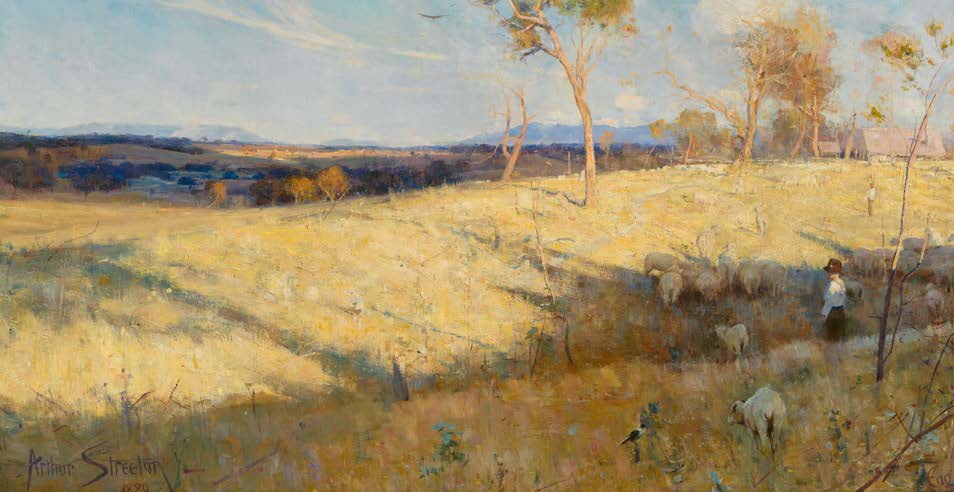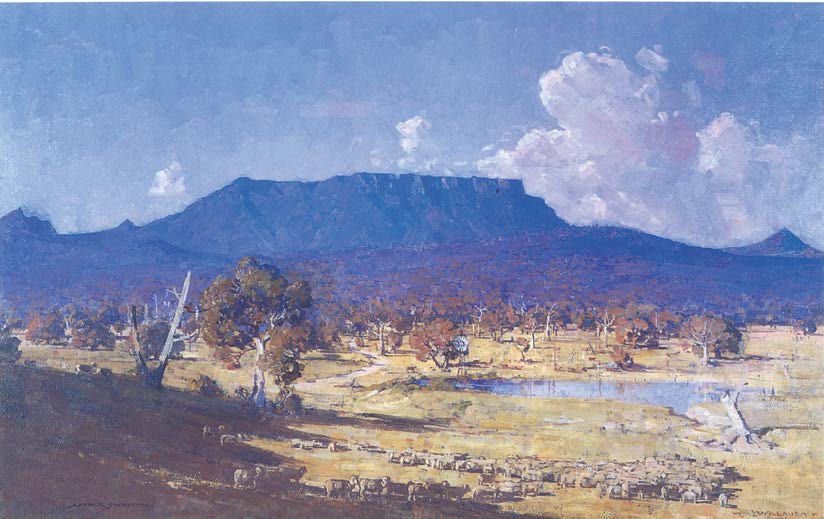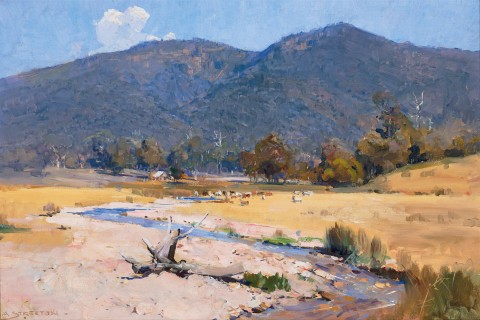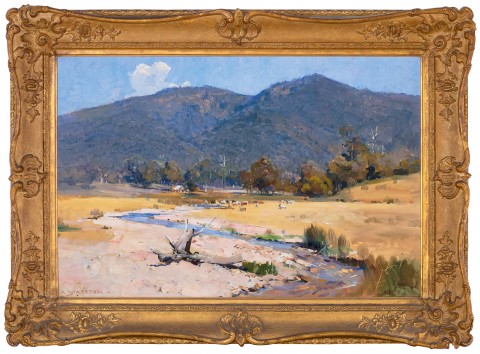OUT OF THE PURPLE MOUNTAINS IT GETS ITS WATERS, 1928
ARTHUR STREETON
oil on canvas on composition board
50.0 x 76.0 cm
signed lower left: A STREETON.
bears inscription on label attached verso: ‘Out of the Purple Mountains / it gets its Waters’ / Arthur Streeton / The Property of …
Macquarie Galleries, Sydney
Mr Charles David Murray, Sydney
Thence by descent
Private collection
Lawsons, Sydney, 19 June 1984, lot 104 (as 'Out of the Purple Mountains It Gets Its Waters (Creek from Purple Hill)')
Earl Gallery, Victoria
Private collection, Victoria, acquired from the above in July 1984
Exhibition of Recent Paintings: Arthur Streeton, Macquarie Galleries, Sydney, 4 – 15 April 1929 (as ‘Drawing its Water from the Purple Hill’)
‘Art Exhibitions: Mr. Streeton’s Paintings’, The Sydney Morning Herald, Sydney, 4 April 1929, p. 8 (as ‘Drawing its Water from the Purple Hill’)
Tildesley, B., ‘Oil Paintings by Arthur Streeton’, Sydney Mail, Sydney, 10 April 1929, p. 29 (as ‘Drawing its Water from the Purple Hill’)
Streeton, A., The Arthur Streeton Catalogue, Melbourne, 1935, cat. 980 (as 'Creek, from Purple Hill')
DH2022 ART Cat (May 2022) FA3 n.jpg

‘Arthur Streeton has done for Australia what… Constable did for England, Claude for Italy, Daubigny and Corot for France. He has fixed the character of our landscape for all time... I attribute this to his mastery of the painting of light and a perfect colour sense, always faithful to the mood of the hour.’1
So proclaimed Lionel Lindsay, well-known artist and arts commentator, in the special issue of Art in Australia that was published in 1931 to celebrate the art of Arthur Streeton. That same year, Streeton – then in his sixties and widely celebrated as one of Australia’s finest painters – was honoured with a retrospective exhibition at the National Art Gallery of New South Wales, the first Australian artist to be acknowledged in this way during his lifetime. He would receive the highest honour of the day some years later when, in 1937, he was knighted for his services to art.
As a young man in the 1880s and 90s, Streeton, along with his friends, Tom Roberts, Charles Conder and Frederick McCubbin, had transformed the depiction of the Australian landscape. Discarding traditional academic techniques and rules of representation, these so-called Australian Impressionists instead emphasised the naturalistic effects of light and colour, often painting outdoors, and producing atmospheric and painterly ‘impressions’ of their subjects.2 Streeton, in particular, became associated with images which cast the rural Australian landscape in shades of blue and gold, sun-bleached paddocks and golden plains glowing beneath vast blue skies. Exhibited at the Royal Academy, London in 1891 and awarded a Mention Honorable at the Paris Salon the following year, Golden summer, Eaglemont, 1899 (National Gallery of Australia) exemplifies this aspect of his oeuvre. Long recognised as a masterpiece of Australian art, this light-filled pastoral scene is at once romantic and yet, even to contemporary eyes, somehow also entirely realistic.
DH2022 ART Cat (May 2022) FA3 g.jpg

The poetically titled Out of the purple mountains it gets its waters, 1928, continues this theme but brings into view a majestic mountain that separates the blue sky, a puff of white cloud on the horizon, from the grassy golden foreground. Streeton’s mastery of his medium and facility with the brush is on full display in this painting, from the lively daubs of paint that make up the purple mountains to the reedy growth in the lower right, which is convincingly described in just a few fine brushstrokes. The composition leads the viewer through the landscape in a gentle zig-zag motion, following the contours of the mountains through the band of trees that makes up the middle ground, joining up with the stream which flows to the front of the picture plane. Displayed in Streeton’s solo exhibition at Macquarie Galleries, Sydney in 1929, this painting prompted the Sydney Mail critic to declare that ‘There is no Australian painter as yet who can surpass him in the representation of spacious landscapes… [Out of the purple mountains it gets its waters] is joyously characteristic of Streeton in the rendering of the stream winding along the sandy flats.’3
This painting shares much in common with another major work of the time, Land of the Golden Fleece (Art Gallery of New South Wales), 1926, which depicts the dramatic landscape around the Grampians in Western Victoria, an area Streeton visited in November of that year.4 While this view is more expansive and takes in a broad vista, the palette is similar, as is the overall composition, which uses the flat-topped mountain as a backdrop for its pastoral scene, complete with dense stands of trees, the ubiquitous windmill and dam, and flock of grazing sheep. Such images served another significant purpose during these years, reinforcing a proud sense of national identity and a path towards recovery for a country that had suffered many losses in the First World War. As Ian Burn wrote, ‘In the postwar period, artists returned to the theme of the Australian landscape with a changed idea of its value and meaning… the war had imbued the landscape with a new power and authority… The masculine ideals of war were used to promote and validate a particular landscape of peace, an ideal of pastoral wealth and national potential’.5
1. Lindsay, L., ‘Arthur Streeton, Art in Australia, third series, no. 40, October 1931, p. 11
2. For an analysis of these artists’ work in relation to French Impressionism, see Vaughan, G., ‘Some Reflections on Defining Australian Impressionism’ in Lane, T., Australian Impressionism, National Gallery of Victoria, Melbourne, 2007, pp. 16 – 19
3. Tildesley, B., ‘Oil Paintings by Arthur Streeton’, Sydney Mail, Sydney, 10 April 1929, p. 29
4. Streeton painted three versions of this subject. The Art Gallery of New South Wales version is illustrated here. For the other two, see Eagle, M., The Oil Paintings of Arthur Streeton in the National Gallery of Australia, National Gallery of Australia, Canberra, 1994, pp. 184 – 87, and Smith, G., Arthur Streeton 1867-1943, National Gallery of Victoria, Melbourne, 1995, pp. 170 – 171
5. Burn, I., National Life and Landscapes: Australian Painting 1900 – 1940, Bay Books, Sydney, 1991, pp.79 – 80, quoted in Eagle, ibid., pp. 186 – 87
KIRSTY GRANT

